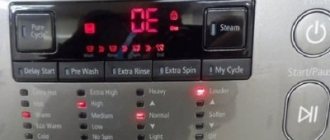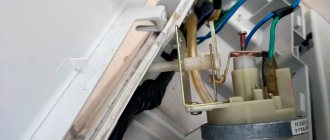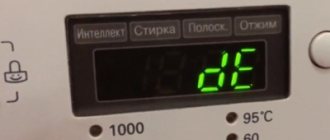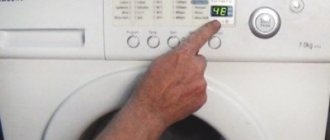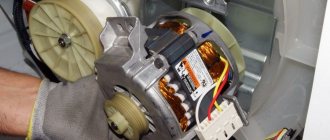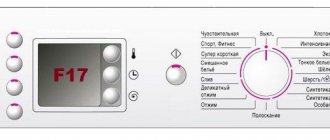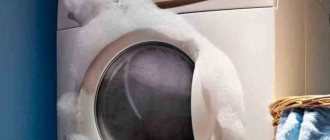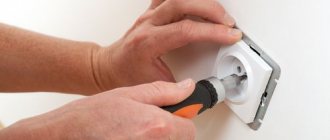Published: 30 Sep 2020
You turned on the machine, it washed quietly, but when it switched to the spin cycle, it shook violently and began to bounce. You don’t know what happened, but you want to understand why the washing machine began to shake like a vibration stand.
Let's start with the fact that the washer should vibrate when the drum picks up speed. In normal conditions, vibration does not go beyond what is reasonable, because it is compensated by the design of the machine. But a vigorously jumping washing machine already indicates that there is some kind of problem.
Let's figure out why the automatic washing machine shakes during the spin cycle. And is it always necessary to call a specialist to get rid of excessive vibration?
Causes of strong vibration:
There are quite a few reasons for this kind of malfunction, many of them can be eliminated yourself, since the difficulty in eliminating them will not be more difficult. Let's first consider the simplest problems in which the machine begins to vibrate strongly, shake, jump and make uncharacteristic noise.
Shipping bolts not removed
One of the most common reasons why a washing machine starts to shake and jump is when they forget to remove the shipping bolts (fasteners) that are located at the back of the unit on a newly purchased machine, usually there are no more than 5 of them depending on the model. They are intended to secure the drum during transportation, so that the tank in the places where the springs are attached does not fly off the seats, and also protect the drum suspension from damage.
The removed fasteners should not be thrown away, as they may be useful to you the next time you transport your machine.
It is worth noting that when removing fasteners, you should follow the operating instructions supplied with the machine!
Dismantling sequence:
- Start unscrewing the screws until they become loose.
- Pull them out of the hole.
- Insert the plugs into the holes on the rear panel.
After removing the fasteners, the tank should hang on the springs.
Incorrect installation
Another common problem that causes the washing machine to jump and move during the spin cycle is improper installation. The main condition for the normal operation of the machine is its strictly horizontal position on a flat and non-slippery floor. The machine has legs at the bottom that are easily adjusted with a key; adjust them so that it does not wobble and stands stable; you should also level it using a building level (spirit level). It is advisable to lay a rubber mat under the unit if the floor, for example, is made of tiles.
It is not recommended to install the washing machine on soft objects!
Linen imbalance
The reason why the washing machine jumps is the uneven distribution of the laundry in the drum or, as they also say, an imbalance of the laundry. This happens when the laundry is distributed in one place, for example in the duvet cover. In this case, stop the washing, turn off the power to the unit, wait until the door is unlocked, then open it; if the door does not open, use the emergency drain of water, then distribute the items in the drum evenly so that they do not clog in one place again. This reason is more typical for cars that were released some time ago. Today they are equipped with the function of uniform distribution of laundry.
Overload of laundry
Excessive weight of laundry can also lead to abnormal vibration, so empty the excess clothes from the drum and you can start the wash again. Basically, with such problems, modern machines display error codes on the display; they may differ from one another for different models.
It is not advisable to load items into the machine that absorb large amounts of water, such as terry cloth, because this will increase the weight of the items being washed. In this case, it is better to reduce the amount of laundry loaded.
Attention! Before removing laundry from the drum, make sure that your washing machine is de-energized!
Call the master
In case of complex equipment breakdowns, you need to call a specialist from a washing machine repair company. By giving preference to responsible companies that have been operating for years, you can protect yourself from scammers and unprofessionals.
The cost of repair work does not include the price of new parts. The average prices in Moscow are as follows:
- removal of transportation bolts – from 1,400 rubles;
- replacement of springs - from 2,500 rubles;
- replacement of shock absorbers - from 2,900 rubles;
- removal of a foreign object – from 1,700 rubles;
- replacement of counterweight – from 2,300 rubles, etc.
The final price for LG repairs is determined on the spot. After the washing machine is restored to working order, a test run is performed and the technician issues a guarantee for the work performed.
Causes of strong noise and shaking:
Bearing wear
Another common cause of vibration is worn bearings. When the seal is no longer sealed and moisture begins to enter the bearing, a process of gradual corrosion and subsequent destruction begins. First, a grinding sound appears, then the spin cycle begins to be accompanied by strong vibration. Then you just need to replace the bearing, and if this is not done in time, the machine may be seriously damaged. This is already a rather serious malfunction, in this case it is better to contact specialists; if you want to figure it out yourself, then read the article on how to change bearings yourself.
Debris getting between the tank and the drum
It happens that a foreign object gets into the space between the drum and the tank, causing noise and grinding. This mainly happens when they forget to remove everything unnecessary from their pockets, and it is also not a rare case when a bra wire gets caught. To remove debris, you need to remove the heating element (heating element) and remove all excess through the hole. You can also remove debris from the drain pipe.
It is important to know! Before you start washing, always make sure that there is nothing in your pockets; you should fasten the zippers and buttons on your clothes!
Electric motor is faulty
If the washing machine, after starting the wash, takes in water and after a while the drum begins to spin sharply, and at high speeds, this will cause severe shaking. The whole problem is the malfunction of the tachometer. This sensor is located in the electric motor, which is located on the rear. The tachometer is used to adjust the shaft rotation speed. This is no longer a simple repair that requires qualifications. It is best to contact a specialist and consult with him.
Shock absorbers are faulty
Shock absorbers are often the source of the problem. Faulty shock absorbers cause severe knocking and vibration. Shock absorbers are designed to dampen vibrations of the tank and beating against the body. They are always used in conjunction with spring mechanisms. Mostly they dry out. It is quite simple to make sure that they are in good working order: open the hatch, pull the tank towards you and immediately release it. The drum in place indicates that there is no cause for concern. If the drum begins to oscillate in all directions, this indicates the need to replace them with others.
Counterweight faulty
Vibrations during spinning also occur due to loose fastenings of the counterweights, so the process of their destruction begins in the places of fastenings. Counterweights can be plastic or concrete, which tend to crumble after some time of operation. But most often there are problems with fastening. If a similar situation arises, then it is worth replacing the mounting bolts or adjusting the counterweight.
What to do if the counterweight bursts and splits into two parts? The best solution to this problem is, of course, to replace it with a new one, but it is not so easy to find, so you can try to fix the counterweight yourself if it is not plastic. You need to dilute PVA glue with cement and glue the parts together. After the operations, you need to make sure that all parts are well glued, after which you can try to start the wash.
Counterweights and springs
The washing machine has two concrete, so-called “counterweights”. One is located behind the tank, the other can be in front of it. They are made of high strength concrete and grade (I read somewhere that it is 800 - 900). They have special fasteners, bolts that hold this entire structure, as well as special springs.
What malfunctions could there be:
- The counterweights simply fall apart into two or even three parts. They need to be replaced, but they cannot always be found, due to the old age of the model or even due to the high cost. Therefore, many craftsmen restore the original ones (using cement with PVA glue), or tighten them with belts or metal plates
- Counterweight bolts. The bolts can simply come loose due to prolonged use. Just disassemble the machine and stretch them
- The springs (or their fastenings) may break. Everything here is quite easy, you just need to replace
In both the first and second cases, the machine will jump and rumble, even if it is installed correctly.
What to do if the drum is knocking in the washing machine
You need to take certain actions depending on the cause of the knocking.
Uneven distribution of things
This problem is typical for older machines. In them, when washing and spinning, things do not straighten out, but clump together. In order for the centrifuge to stop knocking, when loading laundry, you need to lay it out evenly, without overloading the drum. It is also advisable to wash bedding and clothing separately.
Foreign object getting inside
Sometimes, when operating the machine, small objects fall out through the holes in the centrifuge into the space between it and the outer tank, for example, a bra wire, a button, or a small item that might have fallen out of your pockets. In this case, in order to remove a foreign object, if it cannot be reached through the door cuff, the device will have to be disassembled. To get to the space where the thermal electric heaters are located, depending on the model, it is necessary to remove the rear or front panel of the unit.
Read more ► Zanussi washing machine: faults and their elimination, how to repair it yourself
Incorrect installation of the washing machine
If errors were made during the installation of equipment, then in accelerated operation this is especially noticeable. In this case, it is necessary to check the correct location of the unit and make the necessary adjustments. In order to determine whether the car is level, you can use a level. If distortions are detected, it can be moved to a more even surface. In some models, the position can also be adjusted using screw-in and screw-out legs.
Advice! Do not place the washing machine close to a wall or furniture. There should be a small space between them.
Shock absorber wear
To fix internal damage, you will most likely have to contact a specialist. The springs that ensure smooth rotation of the drum become unusable due to prolonged or intense use, which causes excessive knocking. Replacing the shock-absorbing mechanism will solve this problem.
Counterweight failure
Another problematic part that causes the washing machine to start knocking can be the counterweight - a special weight designed to balance the moving structure during operation. If noise and rattling occur during the washing process, the reason may lie in a loose balancer mount. To eliminate this drawback, it is necessary to disassemble the body of the washing machine and adjust the position of the counterweight.
Bearing wear
If the washing machine is used for a long time or in violation of the general rules, then the drum bearings are also subject to wear, which ultimately leads to creaking and unwanted vibration. The bearing mechanism is replaced taking into account the model of the unit and its functional features.
Line filter failure
A typical element of all models is a surge protector. It is located behind the back cover and serves to equalize electrical voltage. When the washing machine is operating, this part may become detached and knock on the body and internal parts. For repairs, the back panel is removed, after which the filter is screwed into place using new fasteners.
Read more ► The washing machine is leaking from below: the main causes and troubleshooting
